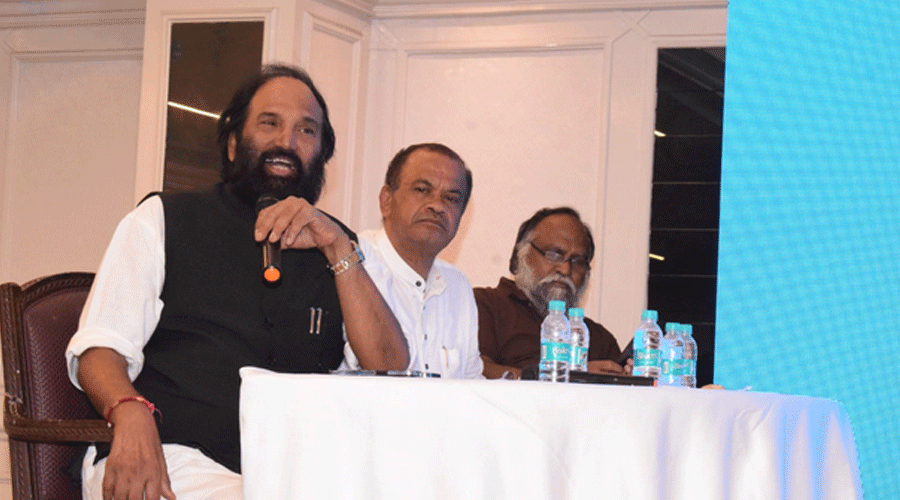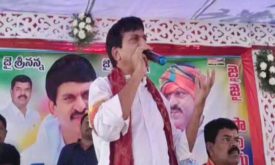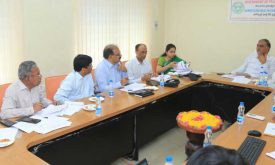KCR’s allegations on Congress Govt are a bundle of lies: Uttam Kumar Reddy
Hyderabad : Civil Supplies and Irrigation Minister Capt N Uttam Kumar Reddy has described the allegations levelled by BRS chief and former Chief Minister K Chandrashekhar Rao against the Congress Government as a bundle of lies.
Uttam Kumar Reddy said there was no iota of truth in the accusations made by KCR on irrigation, energy, paddy procurement and other issues during an interview with a regional news channel. He said the Congress Government has been trying to resolve the problems which they inherited from the previous BRS Government. However, he said KCR has been spreading lies like Goebbels propaganda as a last attempt to cover up his failures. “BRS party is on the stage of extinction. The BRS tally of MLAs came down from 104 to 39. Of them, 25 MLAs are ready to join the Congress. It is not going to win a single seat in the Lok Sabha elections, and its candidates will lose deposits in a majority of seats. Its existence is doubtful after the Lok Sabha elections,” he said.

The Irrigation Minister gave a detailed PowerPoint presentation on Krishna water issues. He asserted that KCR’s claim of boosting power generation capacity from 7,000 megawatts to 12,000 is a blatant falsehood. According to him, the BRS Government completed only the Bhadradri Power Plant over the course of ten years. Moreover, the technology employed in this plant was outdated and far from innovative.
Uttam Kumar Reddy accused K Chandrashekhar Rao (KCR) of betraying the interests of Telangana regarding the allocation of Krishna River water. He noted that when Andhra Pradesh was a unified state, the Krishna River had a total of 811 TMCs (thousand million cubic feet). However, after the state’s bifurcation, Telangana’s share was drastically reduced to just 299 TMCs, indicating a significant loss of water resources.
Uttam Kumar Reddy criticized the KCR Government for entering into an interim ad-hoc agreement on June 18-19, 2015, with the Andhra Pradesh (AP) Government to share 811 TMC of Krishna River water in a 512:299 ratio, favouring AP. He stated that the agreement was made without understanding the historical injustices surrounding water allocation, leading to serious implications for Telangana. According to Reddy, the Krishna Water Disputes Tribunal I (KWDT-I) didn’t make project-specific allocations but instead provided en bloc allocations. The Supreme Court upheld this approach, yet the ad-hoc agreement was framed as if it was based on project-specific allocations, which wasn’t accurate.
Uttam Kumar Reddy further highlighted that, despite Telangana’s larger catchment area, more drought-prone regions, a higher basin population, and a greater cultivable area, it was eligible for a 70% ratio and should have negotiated a more favourable allocation. However, by agreeing to the 299:512 split, Telangana’s future claims were restricted, allowing AP to rely on this agreement to push for similar water sharing in tribunals and other forums. This left Telangana in a challenging position, making it nearly impossible to revise the agreement.
He pointed out that KCR’s agreement had a detrimental impact on the joint districts of Mahbubnagar and Nalgonda, significantly reducing their water share. Moreover, during the Apex Council meeting on September 21, 2016, KCR agreed to extend the 2015-16 working arrangement for another year. According to Reddy, this was a missed opportunity for KCR to renegotiate a better share of water for Telangana. Later, on October 6, 2020, KCR stated that the working arrangement between Telangana and AP would continue until the Tribunal finalized water sharing under Section 3, indicating the ongoing challenges posed by the original agreement.
He stated that KCR should have raised concerns and sought a revision of the water-sharing agreement, but instead, he chose to continue with the existing arrangement until the Tribunal reached a decision. This approach, according to him, has significant consequences and creates a situation that is now difficult to reverse. After Telangana was formed, Andhra Pradesh used more than its allotted water, while Telangana failed to use its entire allocation. Uttam Kumar Reddy stated that this indicated complacency and negligence by the previous government, jeopardizing Telangana’s water rights.
He also mentioned that Andhra Pradesh exceeded its water allocation in both the left and right canals, whereas Telangana could not fully utilize its own share except for a few years. Specifically, AP’s excess drawal in the Nagarjuna Sagar Right Canal (NSRC) was 27.77 TMC in 2019-20, 39.23 TMC in 2020-21, 33.65 TMC in 2021-22, and 66.90 TMC in 2022-23. According to Reddy, this pattern of overuse by Andhra Pradesh, combined with Telangana’s underutilization, reflects poor water resource management by the previous BRS Government.
Regarding the Muchumarri Lift Irrigation Scheme (LIS), Uttam Kumar Reddy pointed out that after 2014, the capacity of the Malyala pump house was increased from 3,850 cusecs to 6,300 cusecs, with water drawn from a depth of 833 feet. Similarly, the capacity at the Muchumarri pump house was enhanced from 3,850 cusecs to 6,300 cusecs, with water drawn from 798 feet. This resulted in a total drawing capacity of 12,600 cusecs (approximately 1.09 TMC/day) at the Handri-Neeva Sujala Sravanti (HNSS) project in Andhra Pradesh. The then-Chief Minister of Andhra Pradesh inaugurated the scheme on September 8, 2017. Uttam Kumar Reddy mentioned that KCR should have filed a complaint against these developments as early as October 2016 but failed to do so, losing two valuable years to contest these changes.
In a similar vein, Uttam Kumar Reddy noted that the capacity of the Rayalaseema Lift Irrigation Scheme (RLIS) was increased to 92,592 cusecs. Despite having met with Andhra Pradesh Chief Minister Jagan Mohan Reddy twice—in May 2019 and January 2020—KCR did not raise any objections to these expansions. If the RLIS scheme were to be completed, Andhra Pradesh would potentially usurp all the initial monsoon flows into the Srisailam Reservoir from its rock bottom (+797 ft), potentially causing a devastating impact on the Nagarjuna Sagar Project (NSP).
Further, Uttam Kumar Reddy criticized the Telangana government for indirectly facilitating the expansion of RLIS by seeking the postponement of the Apex Council meeting, originally scheduled for August 5, 2020, by writing a letter on July 30, 2020, requesting it to be held after August 20, 2020. This rescheduling happened after the tender process for RLIS closed on August 10, 2020, essentially aiding Andhra Pradesh by allowing a smooth tendering process. He suggested that if the Telangana government had opposed the postponement and attended the Apex Council meeting to raise the issue, the Government of India might have taken action to halt the tender process.
Uttam Kumar Reddy noted that the Telangana government did not file a case with the Supreme Court or the existing Krishna Water Disputes Tribunal (KWDT-II) when the Government Order (GO) was issued. A resident of Mahabubnagar, Govinolla Srinivas, filed a case on May 15, 2020, with the National Green Tribunal (NGT) in Chennai to restrain Andhra Pradesh from proceeding with RLIS, and the Telangana government joined the proceedings later.
Unfortunately, due to the inaction of the then-Telangana government, the Palamuru Rangareddy Lift Irrigation Scheme (PRLIS), initiated on August 8, 2013, and the Rayalaseema Lift Irrigation Scheme (RLIS), which had its first GO issued on May 5, 2020, were treated similarly by the Government of India. If Telangana had completed the construction of PRLIS by 2019, it would have had a stronger position compared to RLIS.
Additionally, Uttam Kumar Reddy mentioned that Andhra Pradesh’s water drawing capacities before and after state formation have increased significantly, from 4.1 TMC per day to 9.6 TMC per day, indicating rapid expansion and highlighting the Telangana government’s need to address the issues of water sharing and resource management.
Uttam Kumar Reddy criticized KCR for the damage to the Medigadda barrage during the BRS regime. He accused KCR of staying silent for 45 days after the project collapsed. He noted that KCR did not acknowledge responsibility but instead released water after the collapse, creating a false narrative and pushing blame elsewhere.
Regarding the Dindi Lift Irrigation Scheme (LIS), Uttam Kumar Reddy emphasized that no court or tribunal had issued any restraint orders on the construction of these projects. Despite this, the previous government did not prioritize the construction, failing to prepare a Detailed Project Report (DPR) or submit proposals to the Ministry of Environment, Forest, and Climate Change (MoEF) for environmental clearance. As a result, Telangana was penalized by the National Green Tribunal (NGT) for non-compliance.
Uttam Kumar Reddy pointed out that the construction of the Dindi LIS reservoirs commenced without finalizing intake works, indicating negligence by the previous government, which severely affected drought-prone and fluoride-affected areas of the Nalgonda district. He criticized the prior government officials for shedding crocodile tears while neglecting critical projects that could have mitigated the district’s water scarcity. The Congress Government, Uttam Kumar Reddy said, is committed to completing the Dindi project within its term.
In addition, he highlighted delays in the SLBC Tunnel Scheme, where Tunnel 1 was 43.93 km long. Despite starting work with two tunnel boring machines (TBMs), only 11.30 km of excavation and lining were completed between 2014 and 2023, leaving 9.56 km still pending. The lack of progress resulted in lost opportunities for gravity-fed irrigation from the Srisailam Reservoir at 825 feet, forcing farmers to rely on costly lift schemes, leading to substantial financial burdens and recurring costs. He criticized the state government for its poor planning and lack of foresight in sustainable agricultural development. Despite KCR’s promise to complete the tunnel by sitting on a chair at the site, no tangible progress was made.
Uttam Kumar Reddy also pointed out that projects like Udayasamudram and Brahmana Vellemla were neglected. Although construction of headworks for Udayasamudram was completed, the distributary system was delayed due to pending land acquisition, affecting over 2,190 acres, resulting in an inability to serve 100,000 acres of farmland.
Regarding the transfer of projects to the Krishna River Management Board (KRMB), Uttam Kumar Reddy stated that the Congress Government outrightly rejected the proposal, even passing a resolution in the Assembly to protect Telangana’s interests. The current Congress Government, he said, is committed to completing ongoing projects in the Nalgonda district to support an ayacut of 1,350,494 acres.
He reiterated his critique of the Kaleshwaram Project, calling it a major scam and ridiculing KCR’s claims about the stabilization of ayacut. According to Reddy, the total water lifted from the Medigadda barrage was 163 TMC, but after accounting for transmission losses, the stabilized ayacut was only about 130,000 acres per year, indicating a significant shortfall. He accused KCR of redesigning the Pranahita-Chevella project to start Kaleshwaram for commissions and kickbacks, thereby committing a significant scam in the process.
Uttam Kumar Reddy said there were 7,031 paddy procurement centres under BRS rule. But the Congress Govt set up 7200 centres. This time we have opened the purchase centers 15 days earlier than last year, he said.




